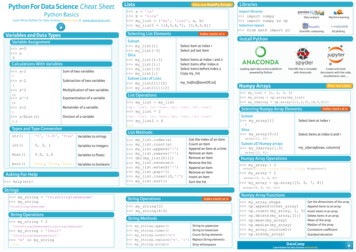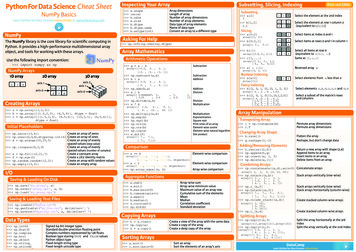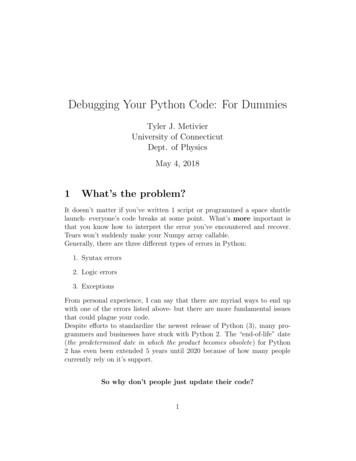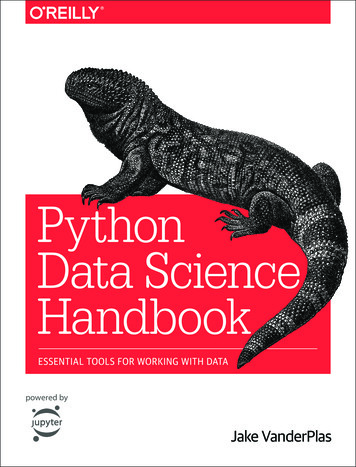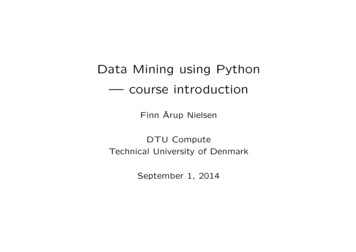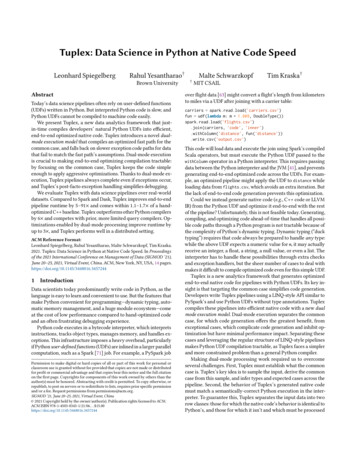
Transcription
Tuplex: Data Science in Python at Native Code SpeedLeonhard SpiegelbergRahul Yesantharao†Brown UniversityAbstractToday’s data science pipelines often rely on user-defined functions(UDFs) written in Python. But interpreted Python code is slow, andPython UDFs cannot be compiled to machine code easily.We present Tuplex, a new data analytics framework that justin-time compiles developers’ natural Python UDFs into efficient,end-to-end optimized native code. Tuplex introduces a novel dualmode execution model that compiles an optimized fast path for thecommon case, and falls back on slower exception code paths for datathat fail to match the fast path’s assumptions. Dual-mode executionis crucial to making end-to-end optimizing compilation tractable:by focusing on the common case, Tuplex keeps the code simpleenough to apply aggressive optimizations. Thanks to dual-mode execution, Tuplex pipelines always complete even if exceptions occur,and Tuplex’s post-facto exception handling simplifies debugging.We evaluate Tuplex with data science pipelines over real-worlddatasets. Compared to Spark and Dask, Tuplex improves end-to-endpipeline runtime by 5–91 and comes within 1.1–1.7 of a handoptimized C baseline. Tuplex outperforms other Python compilersby 6 and competes with prior, more limited query compilers. Optimizations enabled by dual-mode processing improve runtime byup to 3 , and Tuplex performs well in a distributed setting.ACM Reference Format:Leonhard Spiegelberg, Rahul Yesantharao, Malte Schwarzkopf, Tim Kraska.2021. Tuplex: Data Science in Python at Native Code Speed. In Proceedingsof the 2021 International Conference on Management of Data (SIGMOD ’21),June 20–25, 2021, Virtual Event, China. ACM, New York, NY, USA, 14 oductionData scientists today predominantly write code in Python, as thelanguage is easy to learn and convenient to use. But the features thatmake Python convenient for programming—dynamic typing, automatic memory management, and a huge module ecosystem—comeat the cost of low performance compared to hand-optimized codeand an often frustrating debugging experience.Python code executes in a bytecode interpreter, which interpretsinstructions, tracks object types, manages memory, and handles exceptions. This infrastructure imposes a heavy overhead, particularlyif Python user-defined functions (UDFs) are inlined in a larger parallelcomputation, such as a Spark [71] job. For example, a PySpark jobPermission to make digital or hard copies of all or part of this work for personal orclassroom use is granted without fee provided that copies are not made or distributedfor profit or commercial advantage and that copies bear this notice and the full citationon the first page. Copyrights for components of this work owned by others than theauthor(s) must be honored. Abstracting with credit is permitted. To copy otherwise, orrepublish, to post on servers or to redistribute to lists, requires prior specific permissionand/or a fee. Request permissions from permissions@acm.org.SIGMOD ’21, June 20–25, 2021, Virtual Event, China 2021 Copyright held by the owner/author(s). Publication rights licensed to ACM.ACM ISBN 978-1-4503-8343-1/21/06. . . 15.00https://doi.org/10.1145/3448016.3457244Malte Schwarzkopf†Tim Kraska†MIT CSAILover flight data [63] might convert a flight’s length from kilometersto miles via a UDF after joining with a carrier table:carriers spark.read.load('carriers.csv')fun udf(lambda m: m * 1.609, arriers, 'code', 'inner').withColumn('distance', fun('distance')).write.csv('output.csv')This code will load data and execute the join using Spark’s compiledScala operators, but must execute the Python UDF passed to thewithColumn operator in a Python interpreter. This requires passingdata between the Python interpreter and the JVM [41], and preventsgenerating end-to-end optimized code across the UDFs. For example, an optimized pipeline might apply the UDF to distance whileloading data from flights.csv, which avoids an extra iteration. Butthe lack of end-to-end code generation prevents this optimization.Could we instead generate native code (e.g., C code or LLVMIR) from the Python UDF and optimize it end-to-end with the restof the pipeline? Unfortunately, this is not feasible today. Generating,compiling, and optimizing code ahead-of-time that handles all possible code paths through a Python program is not tractable because ofthe complexity of Python’s dynamic typing. Dynamic typing (“ducktyping”) requires that code always be prepared to handle any type:while the above UDF expects a numeric value for m, it may actuallyreceive an integer, a float, a string, a null value, or even a list. Theinterpreter has to handle these possibilities through extra checksand exception handlers, but the sheer number of cases to deal withmakes it difficult to compile optimized code even for this simple UDF.Tuplex is a new analytics framework that generates optimizedend-to-end native code for pipelines with Python UDFs. Its key insight is that targeting the common case simplifies code generation.Developers write Tuplex pipelines using a LINQ-style API similar toPySpark’s and use Python UDFs without type annotations. Tuplexcompiles these pipelines into efficient native code with a new dualmode execution model. Dual-mode execution separates the commoncase, for which code generation offers the greatest benefit, fromexceptional cases, which complicate code generation and inhibit optimization but have minimal performance impact. Separating thesecases and leveraging the regular structure of LINQ-style pipelinesmakes Python UDF compilation tractable, as Tuplex faces a simplerand more constrained problem than a general Python compiler.Making dual-mode processing work required us to overcomeseveral challenges. First, Tuplex must establish what the commoncase is. Tuplex’s key idea is to sample the input, derive the commoncase from this sample, and infer types and expected cases across thepipeline. Second, the behavior of Tuplex’s generated native codemust match a semantically-correct Python execution in the interpreter. To guarantee this, Tuplex separates the input data into tworow classes: those for which the native code’s behavior is identical toPython’s, and those for which it isn’t and which must be processed
in the interpreter. Third, Tuplex’s generated code must offer a fastbail-out mechanism if exceptions occur within UDFs (e.g., a divisionby zero), and resolve these in line with Python semantics. Tuplexachieves this by adding lightweight checks to generated code, andleverages the fact that UDFs are stateless to re-process the offendingrows for resolution. Fourth, Tuplex must generate code with highoptimization potential but also achieve fast JIT compilation, whichit does using tuned LLVM compilation.Dual mode processing enables compilation, but has another bigadvantage: it can help developers write more robust pipelines thatnever fail at runtime due to dirty data or unhandled exceptions. Tuplex detects exception cases, resolves them via slow-path executionif possible, and presents a summary of the unresolved cases to theuser. This helps prototype data wrangling pipelines, but also helpsmake production pipelines more robust to data glitches.The focus of this paper is primarily on multi-threaded processingon a single server, but Tuplex is a distributed system, and we showresults for a preliminary backend based on AWS lambda functions.In summary, we make the following principal contributions:(1) We combine ideas from query compilation with speculativecompilation techniques in the dual-mode processing modelfor data analytics: an optimized common-case code path processes the bulk of the data, and a slower fallback path handlesrare, non-conforming data without inhibiting optimization.(2) We observe that data analytics pipelines with Python UDFs—unlike general Python programs—have sufficient structureto make compilation without type annotations feasible.(3) We build and evaluate Tuplex, the first data analytics systemto embed a Python UDF compiler with a query compiler.We evaluated our Tuplex prototype over real-world datasets, including Zillow real estate adverts, a decade of U.S. flight data [63],and web server logs from a large university. Tuplex outperformssingle-threaded Python and Pandas by 5.8–18.7 , and parallel Sparkand Dask by 5.1–91 (§6.1). Tuplex outperforms general-purposePython compilers by 6–24 , and its generated code comes within2 of the performance of Weld [50] and Hyper [25] for pure queryexecution time, while achieving 2–7 faster end-to-end runtime in arealistic data analytics setting (§6.3). Tuplex’s dual-mode processingfacilitates end-to-end optimizations that improve runtime by up to3 over simple UDF compilation (§6.4). Finally, Tuplex performswell on a single server and distributedly across a cluster of AWSLambda functions (§6.5); and anecdotal evidence suggests that itsimplifies the development and debugging of data science pipelines(§7). Tuplex is open-source at https://tuplex.cs.brown.edu.2Background and Related WorkMany prior attempts to speed up data science via compilation or tocompile Python to native code exist, but they fall short of the idealof compiling end-to-end optimized native code from UDFs writtenin natural Python. We discuss key approaches and systems in thefollowing; Table 1 summarizes the key points.Python compilers. Building compilers for arbitrary Python programs, which lack the static types required for optimizing compilation, is challenging. PyPy [55] reimplements the Python interpreterin a compilable subset of Python, which it JIT-compiles via LLVM(i.e., it creates a self-compiling interpreter). GraalPython [48] usesthe Truffle [23] language interpreter to implement a similar approachwhile generating JVM bytecode for JIT compilation. Numba [30]JIT-compiles Python bytecode for annotated functions on whichit can perform type inference; it supports a subset of Python andtargets array-structured data from numeric libraries like NumPy [2].All of these compilers either myopically focus on optimizinghotspots without attention to high-level program structure, or arelimited to a small subset of the Python language (e.g., numeric codeonly, no strings or exceptions). Pyston [39] sought to create a fullPython compiler using LLVM, but faced memory management andcomplexity challenges [38], and offers only a 20% performance gainover the interpreter in practice [40].Python transpilers. Other approaches seek to cross-compilePython into other languages for which optimizing compilers exist.Cython [4] unrolls the CPython interpreter and a Python moduleinto C code, which interfaces with standard Python code. Nuitka [16]cross-compiles Python to C and also unrolls the interpreter whencross-compilation is not possible. The unrolled code represents a specific execution of the interpreter, which the compiler may optimize,but still runs the interpreter code, which compromises performanceand inhibits end-to-end optimization.Data-parallel IRs. Special-purpose native code in libraries likeNumPy can speed up some UDFs [22], but such pre-compiled codeprecludes end-to-end optimization. Data-parallel intermediate representations (IRs) such as Weld [50] and MLIR [31] seek to addressthis problem. Weld, for example, allows cross-library optimizationand generates code that targets a common runtime and data representation, but requires libraries to be rewritten in Weld IR. Ratherthan requiring library rewrites, Mozart [51] optimizes cross-functiondata movement for lightly-annotated library code. All of these lack ageneral Python UDF frontend, assume static types, and lack supportfor exceptions and data type mismatches.Query compilers. Query compilers turn SQL into native code [1,27, 58, 60, 72], and some integrate with frameworks like Spark [12].The primary concern of these compilers is to iterate efficiently overpreorganized data [26, 59], and all lack UDF support, or merely provide interfaces to call precompiled UDFs written e.g. in C/C .Simple UDF compilers. UDF compilation differs from traditional query compilation, as SQL queries are declarative expressions.With UDFs, which contain imperative control flow, standard techniques like vectorization cannot apply. While work on peeking insideimperative UDFs for optimization exists [18], these strategies failon Python code. Tupleware [6] provides a UDF-aware compiler thatcan apply some optimizations to black-box UDFs, but its Pythonintegration relies on static type inference via PYLLVM [17], and itlacks support for common features like optional (None-valued) inputs,strings, and exceptions in UDFs. Tuplex supports all of these.Exception handling. Inputs to data analytics pipelines ofteninclude “dirty” data that fails to conform to the input schema. Thisdata complicates optimizing compilation because it requires checksto detect anomalies and exception handling logic. Load reject files [8,37, 54] help remove ill-formed inputs, but they solve only part ofthe problem, as UDFs might themselves encounter exceptions whenprocessing well-typed inputs (e.g., a division by zero, or None values).Graal speculatively optimizes for exceptions [11] via polymorphic
System ClassExamplesLimitationsTracing JIT CompilersPyPy [55], Pyston [39]Special Purpose JIT CompilersPython TranspilersData-parallel IRsNumba [30], XLA [32],Glow [56]Cython [4], Nuitka [16]Weld [50], MLIR [31]Require tracing to detect hotspots, cannot reason about high-level program structure,generated code must cover full Python semantics (slow).Only compile well-formed, statically typed code, enter interpreter otherwise; usetheir own semantics, which often deviate from Python’s.Unrolled interpreter code is slow and uses expensive Python object representation.No compilation from Python; static typing and lack exception support.SQL Query CompilersSimple UDF CompilerFlare [12], Hyper [45]Tupleware [6]No Python UDF support.Only supports UDFs for which types can be inferred statically, only numerical types,no exception support, no polymorphic types (e.g., NULL values).Table 1: Classes of existing systems that compile data analytics pipelines or Python code. All have shortcomings that eitherprevent full support for Python UDFs, or prevent end-to-end optimization or full native-code performance.inline caches—an idea also used in the V8 JavaScript engine—butthe required checks and guards impose around a 30% overhead [10].Finally, various dedicated systems track the impact of errors on models [28] or provide techniques to compute queries over dirty data [66,68], but they do not integrate well with compiled code.Speculative processing. Programming language research onspeculative compilation pioneered native code performance fordynam-ically-typed languages. Early approaches, like SELF [5], compiled multiple, type-specialized copies of each control flow unit (e.g.,procedure) of a program. This requires variable-level speculationon types, and results in a large amount of generated code. State-ofthe-art tracing JITs apply a dynamic variant of this speculation andfocus on small-scale “hot” parts of the code only (e.g., loops).A simpler approach than trying to compile general Python is tohave Python merely act as a frontend that calls into a more efficientbackend. Janus [19, 20] applies this idea to TensorFlow, and Snek [9]takes it one step further by providing a general mechanism to translate imperative Python statements of any framework into calls to aframework’s backend. While these frameworks allow for imperativeprogramming, the execution can only be efficient for Python codethat maps to the operators offered by the backend. To account forPython’s dynamic types, such systems may have to speculate onwhich backend operators to call. In addition, the backend’s APIsmay impose in-memory materialization points for temporary data,which reduce performance as they add data copies.In big data applications, efficient data movement is just as important as generating good code: better data movement can be sufficientto outperform existing JIT compilers [51]. Gerenuk [44] and Skyway [46] therefore focus on improving data movement by specializing serialization code better within the HotSpot JVM.Tuplex. In Tuplex, UDFs are first-class citizens and are compiledjust-in-time when a query executes. Tuplex solves a more specializedcompilation problem than general Python compilers, as it focuses onUDFs with mostly well-typed, predictable inputs. Tuplex compiles afast path for the common-case types (determined from the data) andexpected control flow, and defers rows not suitable for this fast pathto slower processing (e.g., in the interpreter). This simplifies the tasksufficiently to make optimizing compilation tractable.Tuplex supports natural Python code rather than specific libraries(unlike Weld or Numba), and optimizes the full end-to-end pipeline,including UDFs, as a single program. Tuplex generates at most threedifferent code paths to bound the cost of specialization (unlike SELF);and it speculates on a per-row basis, compared to a per-variable basisin SELF and whole-program speculation in Janus. Tuplex uses thefact that UDFs are embedded in a LINQ-style program to providehigh-level context for data movement patterns and to make compilation tractable. Finally, Tuplex makes exceptions explicit, and handlesthem without compromising the performance of compiled code:it collects exception-triggering rows and batches their processing,rather than calling the interpreter from the fast path.3Tuplex OverviewTuplex is a data analytics framework with a similar user experienceto e.g., PySpark, Dask, or DryadLINQ [70]. A data scientist writes aprocessing pipeline using a sequence of high-level, LINQ-style operators such as map, filter, or join, and passes UDFs as parameters tothese operators (e.g., a function over a row to map). E.g., the PySparkpipeline shown in §1 corresponds to the Tuplex code:c tuplex.Context()carriers riers, 'code', 'code').mapColumn('distance', lambda m: m * 1.609).tocsv('output.csv')Like other systems, Tuplex partitions the input data (here, the CSVfiles) and processes the partitions in a data-parallel way across multiple executors. Unlike other frameworks, however, Tuplex compilesthe pipeline into end-to-end optimized native code before execution starts. To make this possible, Tuplex relies on a dual-modeprocessing model structured around two distinct execution modes:(1) an optimized, normal-case execution; and(2) an exception-case execution.To establish what constitutes the normal case, Tuplex samples the input data and, based on the sample, determines the expected types andcontrol flow of the normal-case execution. Tuplex then uses theseassumptions to generate and optimize code to classify a row intonormal or exception cases, and specialized code for the normal-caseexecution. It lowers both to optimized machine code via LLVM.Tuplex then executes the pipeline. The generated classifier codeperforms a single, cheap initial check on each row to determine ifit can proceed with normal-case execution. Any rows that fail thischeck are placed in an exception pool for later processing, while themajority of rows proceed to optimized normal-case execution. If anyexceptions occur during normal-case execution, Tuplex moves theoffending row to the exception pool and continues with the next row.
Input DataPipelinesampleTuplex Compilercodegen. & compilecodegen.&Row Classifier (compiled)compilenormal case?yesinstead emulates an implicit catch-all exception handler that recordsunresolved (“failed”) rows. Second, Tuplex assumes that UDFs arepure and stateless, meaning that their repeated execution (on thenormal and exception paths) has no observable side-effects.The top-level goal of matching Python semantics influences Tuplex’s design and implementation in several important ways, guidingits code generation, execution strategy, and ionResolve LogicsuccesssuccessfailResult RowsFailed RowsFigure 1: Tuplex uses an input sample to compile specializedcode for normal-case execution (blue, left), which processesmost rows, while the exception-case (red, right) handles theremaining rows. Compiled parts are shaded in yellow.Finally, after normal-case processing completes, Tuplex attempts toresolve the exception-case rows. Tuplex automatically resolves someexceptions using general, but slower code or using the Python interpreter, while for other exceptions it uses (optional) user-providedresolvers. If resolution succeeds, Tuplex merges the result row withthe normal-case results; if resolution fails, it adds the row to a poolof failed rows to report to the user.In our example UDF, a malformed flight row that has a nonnumeric string in the distance column will be rejected and moved tothe exception pool by the classifier. By contrast, a row with distanceset to None, enters normal-case execution if the sample contained amix of non-None and None values. However, the normal-case execution encounters an exception when processing the row and movesit to the exception pool. To tell Tuplex how to resolve this particularexception, the pipeline developer can provide a resolver:# .join(carriers, 'code', 'code').mapColumn('distance', lambda m: m * 1.609).resolve(TypeError, lambda m: 0.0)# .Tuplex then merges the resolved rows into the results. If no resolveris provided, Tuplex reports the failed rows separately.4DesignTuplex’s design is derived from two key insights. First, Tuplex canafford slow processing for exception-case rows with negligible impact on overall performance if such rows are rare, which is the caseif the sample is representative. Second, specializing the normal-caseexecution to common-case assumptions simplifies the generatedlogic by deferring complexity to the exception case, which makesJIT compilation tractable and allows for aggressive optimization.4.1Establishing the Normal CaseException Row PoolAbstraction and AssumptionsTuplex’s UDFs contain natural Python code, and Tuplex must ensurethat their execution behaves exactly as it would have in a Pythoninterpreter. We make only two exceptions to this abstraction. First,Tuplex never crashes due to unhandled top-level exceptions, butThe most important guidance for Tuplex to decide what code to generate for normal-case execution comes from the observed structure ofa sample of the input data. Tuplex takes a sample of configurable sizeevery time a pipeline executes, and records statistics about structureand data types in the sample, as follows.Row Structure. Input data may be dirty and contain differentcolumn counts and column orders. Tuplex counts the columns ineach sample row, builds a histogram and picks the prevalent columnstructure as the normal case.Type Deduction. For each sample row, Tuplex deducts each column type based on a histogram of types in the sample. If the inputconsists of typed Python objects, compiling the histogram is simple.If the input is text (e.g., CSV files), Tuplex applies heuristics. Forexample, numeric strings that contain periods are floats, integersthat are always zero or one and the strings “true” and “false” arebooleans, strings containing JSON are dictionaries, and empty valuesor explicit “NULL” strings are None values. If Tuplex cannot deducea type, it assumes a string. Tuplex then uses the most common typein the histogram as the normal-case type for each column (exceptfor null values, described below).This data-driven type deduction contrasts with classic, static typeinference, which seeks to infer types from program code. Tuplexuses data-driven typing because Python UDFs often lack sufficientinformation for static type inference without ambiguity, and becausethe actual type in the input data may be different from the developer’s assumptions. In our earlier example (§3), for instance, thecommon-case type of m may be int rather than float.For UDFs with control flow that Tuplex cannot annotate withsample-provided input types, Tuplex uses the AST of the UDF totrace the input sample through the UDF and annotates individualnodes with type information. Then, Tuplex determines the commoncases within the UDF and prunes rarely visited branches. For example, Python’s power operator (**) can yield integer or float results,and Tuplex picks the common case from the sample trace execution.Option types (None). Optional column values (i.e, “nullable”) arecommon in real-world data, but induce potentially expensive logicin the normal case. Null-valued data corresponds to Python’s Nonetype, and a UDF must be prepared for any input variable (or nesteddata, e.g., in a list-typed row) to potentially be None. To avoid havingto check for None in cases where null values are rare, Tuplex uses thesample to guide specialization of the normal case. If the frequencyof null values exceeds a threshold δ , Tuplex assumes that None is thenormal case; and if the frequency of null values is below 1 δ , Tuplexassumes that null values are an exceptional case. For frequencies in(1 δ,δ ), Tuplex uses a polymorphic optional type and generatescode for the necessary checks.
Having established the normal case types and row structure usingthe sample, Tuplex generates code for compilation. At a high level,this involves parsing the Python UDF code in the pipeline, typingthe abstract syntax tree (AST) with the normal-case types, and generating LLVM IR for each UDF. The type annotation step is crucialto making UDF compilation tractable, as it reduces the complexityof the generated code: instead of being prepared to process any type,the generated code can assume a single static type assignment.In addition, Tuplex relies on properties of the data analytics setting and the LINQ-style pipeline API to simplify code generationcompared to general, arbitrary Python programs:(1) UDFs are “closed” at the time the high-level API operator (e.g.,map or filter) is invoked, i.e., they have no side-effects onthe interpreter (e.g., changing global variables or redefiningopcodes).(2) The lifetime of any object constructed or used when a UDFprocesses a row expires at the end of the UDF, i.e., there is nostate across rows (except as maintained by the framework).(3) The pipeline structures control flow: while UDFs may contain arbitrary control flow, they always return to the callingoperator and cannot recurse.Tuplex’s generated code contains a row classifier, which processesall rows, and two code paths: the optimized normal-case code path,and a general-case code path with fewer assumptions and optimizations. The general-case path is part of exception-case execution, andTuplex uses it to efficiently resolve some exception rows.Row Classifier. Tuplex must classify all input rows according towhether they fit the normal case. Tuplex generates code for this classification: it checks if each column in a row matches the normal-casestructure and types, and directly continues processing the row onthe normal-case path if so. If the row does not match, the generatedclassifier code copies it out to the exception row pool for later processing. This design ensures that normal-case processing is focusedon the core UDF logic, rather including exception resolution codethat adds complexity and disrupts control flow.Code Paths. All of Tuplex’s generated code must obey the toplevel invariant that execution must match Python semantics. Tuplextraverses the Python AST for each UDF and generates matchingLLVM IR for the language constructs it encounters. Where typesare required, Tuplex instantiates them using the types derived fromthe sample, but applies different strategies in the normal-case andgeneral-case code. In the normal-case code, Tuplex assumes thecommon-case types from the sample always hold and emits no logicto check types (except for the option types used with inconclusivenull value statistics, which require checks). The normal-case pathstill includes code to detect cases that trigger exceptions in Python:e.g., it checks for a zero divisor before any division.By contrast, the general-case path always assumes the most general type possible for each column. For example, it includes optiontype checks for all columns, as exception rows may contain nullsin any column. In addition, the general-case path embeds code forany user-provided resolvers whose implementation is a compilableUDF. But it cannot handle all exceptions, and must defer rows fromthe exception pool that it cannot process. The general-case pathException CaseNormal CaseNormalPath.br i3 %3, %exceptexcept:ret i64 129Exception Row Poolparse with general case typessuccessGeneral Pathsuccesssuccess.br i3 %3, %exceptexcept:ret i64 129failexceptionCode Generationexception4.3Fallback PathPythonInterpreterMerge RowssuccessfailFigure 2: Tuplex’s exception case consists of a compiledgeneral path and a fallback path that invokes the Pythoninterpreter. Exceptions (red) move rows between code paths.therefore includes logic that detects these cases, converts the datato Python object format, and invokes the Python interpreter inline.Tuplex compiles the pipeline of high-level operators (e.g., map,filter) into stages, similar to Neumann [45], but generates up tothree (fast, slow, and interpreter) code paths. Tuplex generates LLVMIR code for each stage’s high-level operators, which call the LLVMIR code previously emitted for each UDF. At the end of each stage,Tuplex merges the rows produced by all code paths.Memory Management. Because UDFs are stateless functions,only their output lives beyond the end of the UDF. Tuplex thereforeuses a simple slab allocator to provision memory from a thread-local,pre-allocated region for new variables within the UDF, and frees theentire region after the UDF returns and T
(UDFs) written in Python. But interpreted Python code is slow, and Python UDFs cannot be compiled to machine code easily. We present Tuplex, a new data analytics framework that just-in-time compiles developers’ natural Python UDFs into efficient, end-to-end optimized nati


